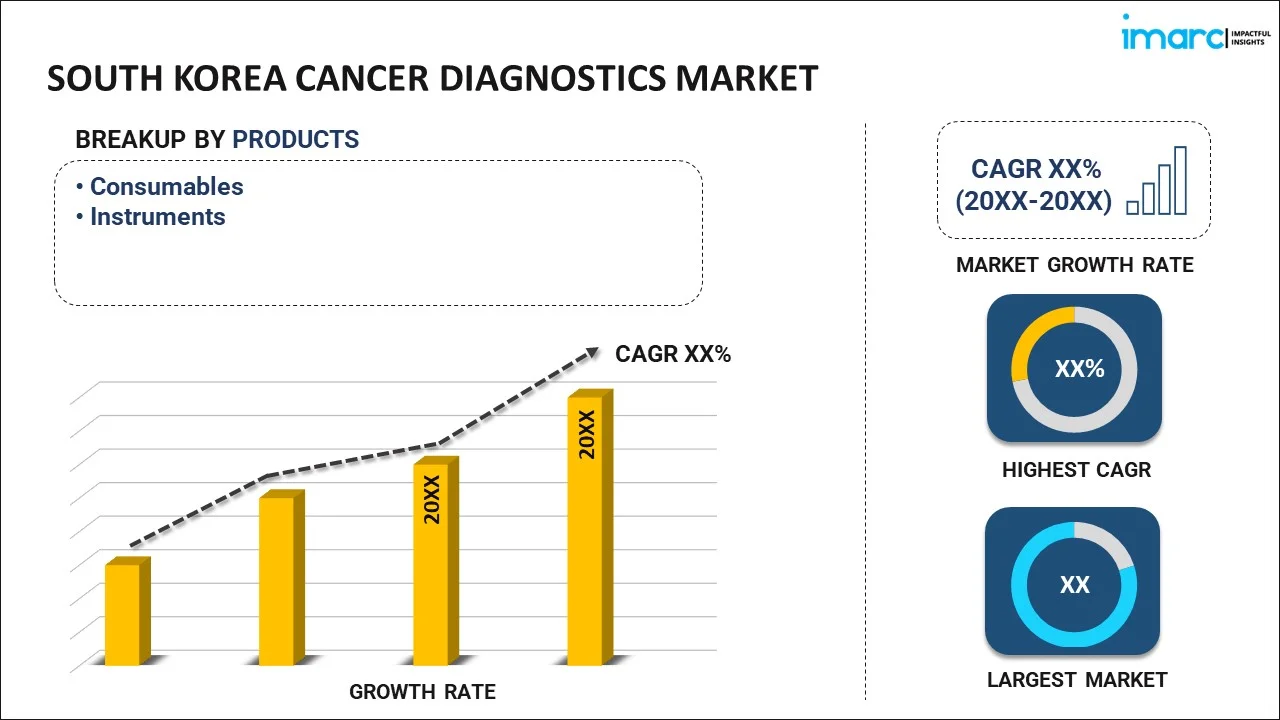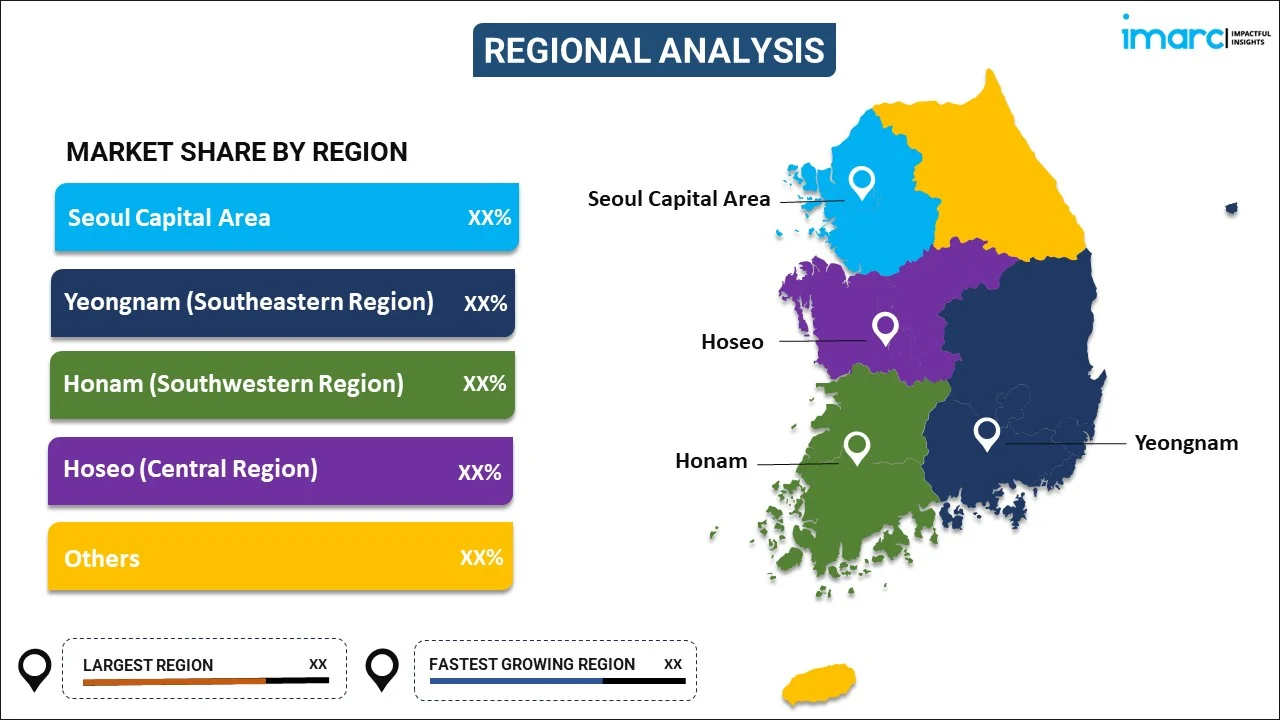
South Korea Cancer Diagnostics Market Report by Product (Consumables, Instruments), Technology (IVD Testing, Imaging, Biopsy Technique), Application (Breast Cancer, Lung Cancer, Colorectal Cancer, Melanoma, and Others), End User (Hospitals and Clinics, Diagnostic Laboratories, and Others), and Region 2025-2033
Market Overview:
South Korea cancer diagnostics market size reached USD 3.9 Billion in 2024. Looking forward, IMARC Group expects the market to reach USD 5.8 Billion by 2033, exhibiting a growth rate (CAGR) of 4.5% during 2025-2033. The introduction of a diverse range of advanced techniques and technologies, including magnetic resonance imaging (MRI), X-rays, and sophisticated laboratory tests, that analyze blood, tissue, and genetic samples is primarily driving the regional market.
|
Report Attribute
|
Key Statistics
|
|---|---|
|
Base Year
|
2024 |
|
Forecast Years
|
2025-2033 |
|
Historical Years
|
2019-2024
|
| Market Size in 2024 | USD 3.9 Billion |
| Market Forecast in 2033 | USD 5.8 Billion |
| Market Growth Rate (2025-2033) | 4.5% |
Cancer diagnostics involves identifying and ascertaining the existence, category, and stage of cancer in individuals. This field incorporates various methods and technologies, including magnetic resonance imaging (MRI), X-rays, and laboratory tests that analyze blood, tissue, and genetic samples. The primary goal is to enable healthcare professionals to precisely identify and evaluate cancerous developments within the body. Additionally, it empowers healthcare providers to enhance patient outcomes by customizing interventions based on the unique characteristics of the disease. This process aids in refining treatment decisions and formulating personalized therapeutic approaches.
South Korea Cancer Diagnostics Market Trends:
The South Korea cancer diagnostics market represents a critical aspect of the nation's healthcare landscape, playing a pivotal role in early detection, precise identification, and effective management of various forms of cancer. One of the primary objectives of the cancer diagnostics market in South Korea is to equip healthcare professionals with the tools necessary for accurate and timely detection of cancer. Additionally, these diagnostic tools enable healthcare providers to ascertain the presence, type, and stage of cancer in individuals, laying the foundation for informed decision-making regarding treatment strategies. Furthermore, the South Korea cancer diagnostics market contributes significantly to the optimization of patient outcomes by facilitating personalized interventions. Through the analysis of blood, tissue, and genetic samples, healthcare professionals can tailor treatment approaches to the specific characteristics of the disease, leading to more effective and targeted therapeutic strategies. As a result, the cancer diagnostics market in South Korea not only aids in the early detection of cancer but also empowers healthcare providers to make informed decisions regarding treatment plans. This approach not only improves patient outcomes but also contributes to the overall effectiveness of cancer management in the country. With a focus on cutting-edge technologies and personalized approaches, the South Korea cancer diagnostics market will remain a crucial component in the nation's efforts to combat and manage the complexities of the disease over the forecasted period.
South Korea Cancer Diagnostics Market Segmentation:
IMARC Group provides an analysis of the key trends in each segment of the market, along with forecasts at the country level for 2025-2033. Our report has categorized the market based on product, technology, application, and end user.
Product Insights:

- Consumables
- Antibodies
- Kits and Reagents
- Probes
- Others
- Instruments
- Pathology-Based Instruments
- Imaging Instruments
- Biopsy Instruments
The report has provided a detailed breakup and analysis of the market based on the product. This includes consumables (antibodies, kits and reagents, probes, and others) and instruments (pathology-based instruments, imaging instruments, and biopsy instruments).
Technology Insights:
- IVD Testing
- Polymerase Chain Reaction (PCR)
- In Situ Hybridization (ISH)
- Immunohistochemistry (IHC)
- Next-Generation Sequencing (NGS)
- Microarrays
- Flow Cytometry
- Immunoassays
- Others
- Imaging
- Magnetic Resonance Imaging (MRI)
- Computed Tomography (CT)
- Positron Emission Tomography (PET)
- Mammography
- Ultrasound
- Biopsy Technique
A detailed breakup and analysis of the market based on the technology have also been provided in the report. This includes IVD testing (polymerase chain reaction (PCR), in situ hybridization (ISH), immunohistochemistry (IHC), next-generation sequencing (NGS), microarrays, flow cytometry, immunoassays, and others), imaging (magnetic resonance imaging (MRI), computed tomography (CT), positron emission tomography (PET), mammography, and ultrasound), and biopsy technique.
Application Insights:
- Breast Cancer
- Lung Cancer
- Colorectal Cancer
- Melanoma
- Others
The report has provided a detailed breakup and analysis of the market based on the application. This includes breast cancer, lung cancer, colorectal cancer, melanoma, and others.
End User Insights:
- Hospitals and Clinics
- Diagnostic Laboratories
- Others
A detailed breakup and analysis of the market based on the end user have also been provided in the report. This includes hospitals and clinics, diagnostic laboratories, and others.
Regional Insights:

- Seoul Capital Area
- Yeongnam (Southeastern Region)
- Honam (Southwestern Region)
- Hoseo (Central Region)
- Others
The report has also provided a comprehensive analysis of all the major regional markets, which include Seoul Capital Area, Yeongnam (Southeastern Region), Honam (Southwestern Region), Hoseo (Central Region), and Others.
Competitive Landscape:
The market research report has also provided a comprehensive analysis of the competitive landscape in the market. Competitive analysis such as market structure, key player positioning, top winning strategies, competitive dashboard, and company evaluation quadrant has been covered in the report. Also, detailed profiles of all major companies have been provided.
South Korea Cancer Diagnostics Market Report Coverage:
| Report Features | Details |
|---|---|
| Base Year of the Analysis | 2024 |
| Historical Period | 2019-2024 |
| Forecast Period | 2025-2033 |
| Units | Billion USD |
| Scope of the Report | Exploration of Historical Trends and Market Outlook, Industry Catalysts and Challenges, Segment-Wise Historical and Future Market Assessment:
|
| Products Covered |
|
| Technologies Covered |
|
| Applications Covered | Breast Cancer, Lung Cancer, Colorectal Cancer, Melanoma, Others |
| End Users Covered | Hospitals and Clinics, Diagnostic Laboratories, Others |
| Regions Covered | Seoul Capital Area, Yeongnam (Southeastern Region), Honam (Southwestern Region), Hoseo (Central Region), Others |
| Customization Scope | 10% Free Customization |
| Post-Sale Analyst Support | 10-12 Weeks |
| Delivery Format | PDF and Excel through Email (We can also provide the editable version of the report in PPT/Word format on special request) |
Key Questions Answered in This Report:
- How has the South Korea cancer diagnostics market performed so far and how will it perform in the coming years?
- What has been the impact of COVID-19 on the South Korea cancer diagnostics market?
- What is the breakup of the South Korea cancer diagnostics market on the basis of product?
- What is the breakup of the South Korea cancer diagnostics market on the basis of technology?
- What is the breakup of the South Korea cancer diagnostics market on the basis of application?
- What is the breakup of the South Korea cancer diagnostics market on the basis of end user?
- What are the various stages in the value chain of the South Korea cancer diagnostics market?
- What are the key driving factors and challenges in the South Korea cancer diagnostics?
- What is the structure of the South Korea cancer diagnostics market and who are the key players?
- What is the degree of competition in the South Korea cancer diagnostics market?
Key Benefits for Stakeholders:
- IMARC’s industry report offers a comprehensive quantitative analysis of various market segments, historical and current market trends, market forecasts, and dynamics of the South Korea cancer diagnostics market from 2019-2033.
- The research report provides the latest information on the market drivers, challenges, and opportunities in the South Korea cancer diagnostics market.
- Porter's five forces analysis assist stakeholders in assessing the impact of new entrants, competitive rivalry, supplier power, buyer power, and the threat of substitution. It helps stakeholders to analyze the level of competition within the South Korea cancer diagnostics industry and its attractiveness.
- Competitive landscape allows stakeholders to understand their competitive environment and provides an insight into the current positions of key players in the market.
Need more help?
- Speak to our experienced analysts for insights on the current market scenarios.
- Include additional segments and countries to customize the report as per your requirement.
- Gain an unparalleled competitive advantage in your domain by understanding how to utilize the report and positively impacting your operations and revenue.
- For further assistance, please connect with our analysts.
 Inquire Before Buying
Inquire Before Buying
 Speak to an Analyst
Speak to an Analyst
 Request Brochure
Request Brochure
 Request Customization
Request Customization




.webp)




.webp)












